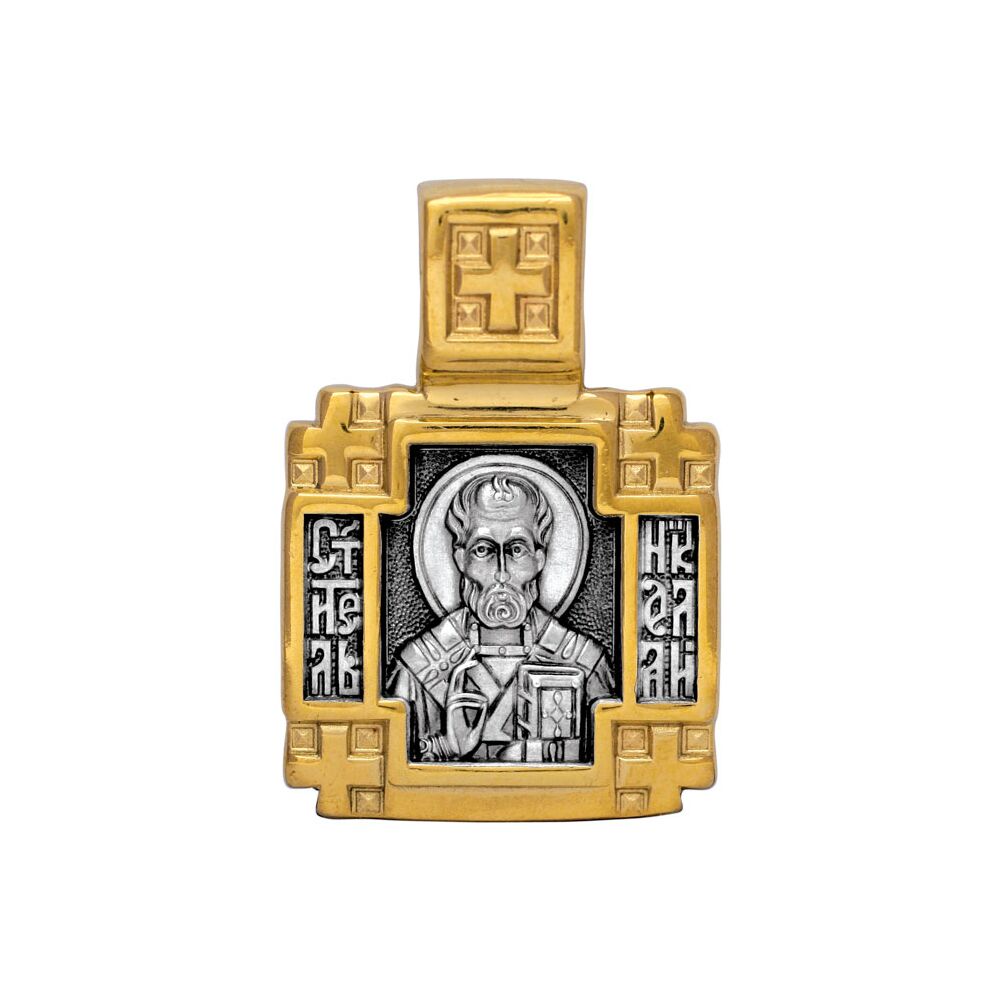Icon Akimov 102.103 «Sainted Hierarch Nicholas the Wondermaker, Archbishop of Myra in Lycia. Guardian Angel»

- Product with tag and seal
- Certificate of authenticity with hologram
- Product description book
- Jewelry Care Memo
- Canvas bag with the «Akimov» company logo
12 months warrantyGuarantee for all purchased goods in our online store is 12 months.
Tracking numberYou receive a Track Number to track each step of the delivery of your order.
Return and exchange - no problemYou can return the items purchased within 14 days. The goods must be in normal condition and have all the factory packages.
Different payment methodsPayment cards VISA and MasterCard, Google Pay, Apple Pay, Visa Checkout, Masterpass
Best priceWe are proud of our prices, hundreds of customers check them every day, which give a choice to our online store!
- Silver (925). Gilding (999).
- Miniature relief, casting, gilding, niello, handwork.
"On the obverse of the locket there is the icon of St. Nicholas the Wondermaker, the image of Guardian Angel being on the reverse. The square shape symbolizes ground and earthly service of the great shepherd.
Sainted hierarch Nicholas was born in the second half of 3d century in Asia Minor, in Patary. From little up the saint manifested extraordinary talents. According to legend during baptizement he spent three hours standing in baptismal bowl on his feet without any support. He had kept off idle amusements in tender age already, but liked to pray, spent his free time reading the Holy Scripture, and did well in his studies. At maturity he became the presbyter of Patary, and some years later – the diocesan of Myrah, Lycia capital.
During the years of shepherding the Holy God-Pleaser became famous for multitude of wonders and charity acts, and had proceeded with them until now. Sainted Hierarch is honored as healer, as patron of those who are on the journey, and as intercessor of all the resentful, persecuted and needy. He is turned to for help in commerce and studies, in clinching arguments and bringing rulers to reason.
Here are the most well known facts of his life. Once the holy archbishop heard about a father who being on his bones decided to sell his daughters. Three times he went up to the poor man house at nights and put secretly bags with gold; and every daughter got her dowry and married happily. In West Europe that history became a legend about St. Nicholaus (Santa Claus) who at Christmas Eve threw into stove pipes (variant: put into stocking or sock) presents for kind and docile children.
Many times while voyaging St. Nicholas pacified storm, healed mutilated sailors and passengers and even raised them from the dead. That is why already in his lifetime a great number of travelers prayed to him in calamity time.
In 325 Sainted Hierarch participated the first Nicene Ecumenical Council. The legend tells that indignant at Arius’s blasphemy against the Lord Jesus Christ (denying of His divine nature), St. Nicholas has slapped the heretic in the face. The Council Fathers considered the action to be inadmissible for an archbishop, divested him of the church rank, and took him into custody. But in the dungeon Jesus Christ and the Most Holy Mother of God appeared before him and handed over the Gospel and the omophorion – tokens of episcopal rank.
“The Nicene wonder” evidenced of St. Nicholaus being chosen by God. Up to date everywhere in the Christendom he is venerated as the greatest wondermaker Even Turkish Moslemin take good care of the tower with the dungeon where he was imprisoned. Images of Christ and of the Most Holy Mother of God with the Gospel and the omophorion in their hands are on almost every icon of St. Nicholaus.
When famine blew up in Lycia St. Nicholas made another wonder. There was a grain merchant who was going to sail away next day with the goods. St. Nicholas appeared in merchant dream and ordered to sail to Lycia. Sainted Hierarch left three gold coins in advance, which in the morning the merchant found gripped in his hand. The merchant took grain to Lycia, sold it to advantage and saved starving people. St. Nicholaus is since venerated both as the intercessor of those who is needy, and as the helper in commerce.
The Holy God-Pleaser is as well honoured as a peacemaker for antagonists, protector of innocently blamed persons, and saviour from vain death. Once in his absence three citizens were innocently condemned to death by Myrah governor. Sainted Hierarch returned to Myrah just before tne execution and was in time for stopping of the executioner hand. Another time by a slander Byzantian emperor condemned three generals to death. The convicts started to wrestle with God praying for St. Nicholas intercession. That very night the Holy God-Pleaser appeared before the emperor and the mayor of the town in their dreams, threatened to deprive them of their power, and demanded to release prisoners. “But who are you to dare demand and threaten, what is more? – The emperor asked. “I am Nicholas, Archbishop of Myra in Lycia!”. The king ordered to retry the generals` case and, ascertained that they are innocent, released them.
Over and over again Sainted Hierarch gave aid to those Christians as well as pagans who needed it, wakening repentance, love and mercy. The Holy God-Pleaser Nicholas lived up to extreme old age and fell peacefully asleep in the Lord on December 19, 342. His incorruptible relics in 1087 were transported to Bari (Italy) staying there hitherto. He is commemorated on December 19 (6) and May 22 (9) (in the day of relics transportation)."
No posts found





